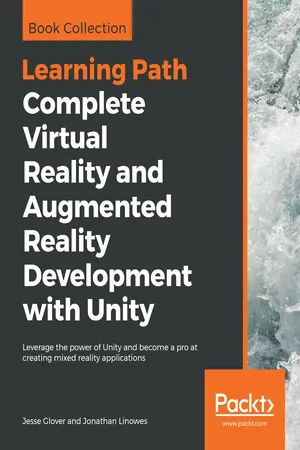
Complete Virtual Reality and Augmented Reality Development with Unity
Leverage the power of Unity and become a pro at creating mixed reality applications
Jesse Glover, Jonathan Linowes
- 668 pages
- English
- ePUB (mobile friendly)
- Available on iOS & Android
Complete Virtual Reality and Augmented Reality Development with Unity
Leverage the power of Unity and become a pro at creating mixed reality applications
Jesse Glover, Jonathan Linowes
About This Book
Get close and comfortable with Unity and build applications that run on HoloLens, Daydream, and Oculus Rift
Key Features
- Build fun augmented reality applications using ARKit, ARCore, and Vuforia
- Explore virtual reality by developing more than 10 engaging projects
- Learn how to integrate AR and VR concepts together in a single application
Book Description
Unity is the leading platform to develop mixed reality experiences because it provides a great pipeline for working with 3D assets.
Using a practical and project-based approach, this Learning Path educates you about the specifics of AR and VR development using Unity 2018 and Unity 3D. You'll learn to integrate, animate, and overlay 3D objects on your camera feed, before moving on to implement sensor-based AR applications. You'll explore various concepts by creating an AR application using Vuforia for both macOS and Windows for Android and iOS devices. Next, you'll learn how to develop VR applications that can be experienced with devices, such as Oculus and Vive. You'll also explore various tools for VR development: gaze-based versus hand controller input, world space UI canvases, locomotion and teleportation, timeline animation, and multiplayer networking.
You'll learn the Unity 3D game engine via the interactive Unity Editor and C# programming.
By the end of this Learning Path, you'll be fully equipped to develop rich, interactive mixed reality experiences using Unity.
This Learning Path includes content from the following Packt products:
- Unity Virtual Reality Projects - Second Edition by Jonathan Linowes
- Unity 2018 Augmented Reality Projects by Jesse Glover
What you will learn
- Create 3D scenes to learn about world space and scale
- Move around your scenes using locomotion and teleportation
- Create filters or overlays that work with facial recognition software
- Interact with virtual objects using eye gaze, hand controllers, and user input events
- Design and build a VR storytelling animation with a soundtrack and timelines
- Create social VR experiences with Unity networking
Who this book is for
If you are a game developer familiar with 3D computer graphics and interested in building your own AR and VR games or applications, then this Learning Path is for you. Any prior experience in Unity and C# will be an advantage. In all, this course teaches you the tools and techniques to develop engaging mixed reality applications.
Frequently asked questions
Information
Content, Objects, and Scale
- A short introduction to the Unity 3D game engine
- Creating a simple diorama in Unity
- Making some measuring tools, including a unit cube and a grid projector
- Using Blender to create a cube with texture maps and importing it into Unity
- Using Google Tilt Brush to create a 3D sketch and importing it into Unity via Google Poly
- Using the experimental Unity EditorXR tools for editing scenes directly in VR
Getting started with Unity
Creating a new Unity project

The Unity editor

- The Scene panel on the upper left-hand side (highlighted) is where you can visually compose the 3D space of the current scene, including the placement of objects.
- Below the Scene panel is the Game view (lower left-hand side), which shows the actual game camera view (presently, it is empty with an ambient sky). When in Play Mode, your game runs in this panel.
- In the center, we have arranged the Hierarchy, Project, and Console panels (from the top to the bottom, respectively).
- The Hierarchy panel provides a tree view of all the objects in the current scene.
- The Project panel contains all the reusable assets for the project, including the ones imported as well as those that you'll create along the way.
- The Console panel shows messages from Unity, including warnings and errors from code scripts.
- On the right-hand side is the Inspector panel (highlighted), which contains the properties of the currently selected object. (Objects are selected by clicking on them in the Scene, Hierarchy, or the Project panel). The Inspector panel has separate panes for each component of the object.
- At the top is the main menu bar (on a Mac, this will be at the top of your screen, not at the top of the Unity window). There's a toolbar area with various controls that we'll use later on, including the Play (triangle icon) button that starts Play mode.
The default world space
Creating a simple diorama
Table of contents
- Title Page
- Copyright
- About Packt
- Contributors
- Preface
- Virtually Everything for Everyone
- Content, Objects, and Scale
- VR Build and Run
- Gaze-Based Control
- Handy Interactables
- World Space UI
- Locomotion and Comfort
- Playing with Physics and Fire
- Animation and VR Storytelling
- What AR is and How to Get Set up
- GIS Fundamentals - The Power of Mapping
- Censored - Various Sensor Data and Plugins
- The Sound of Flowery Prose
- Picture Puzzle - The AR Experience
- Fitness for Fun - Tourism and Random Walking
- Snap it! Adding Filters to Pictures
- To the HoloLens and Beyond
- Other Books You May Enjoy